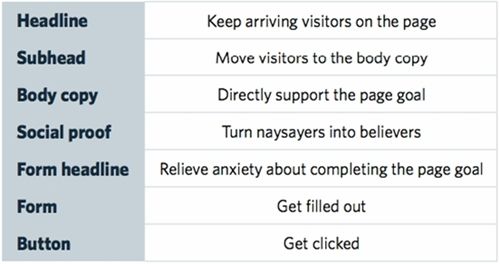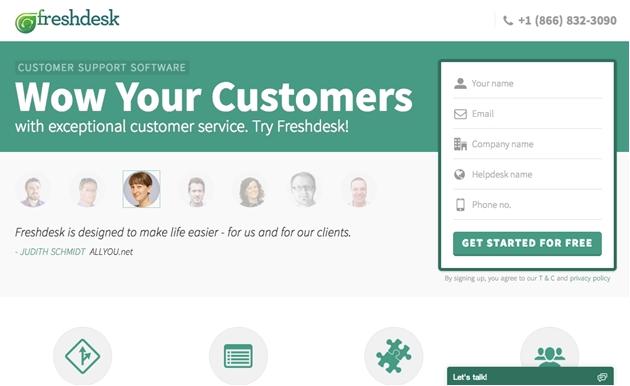Does the following sound familiar?
You're struck with inspiration and you write what you think is killer landing page copy. All the essential elements are there: social proof, your unique value proposition, a detailed list of benefits, and a clear headline. You've also brushed up on your psychology to make your argument more persuasive, and you employ all the best-practices you know.
But then you check your analytics... and in spite of all your hard work, your conversion rate sucks.
What gives?
Writing a persuasive landing page isn't as simple as running through a checklist of best-practices.
To write landing page copy that converts like crazy, you need to take a step back and look at the larger picture: Are you creating a seamless, engaging experience that is custom-tailored to your prospects' goals, pushing them closer to that precious conversion?
In "The Conversion Marketer's Guide to Landing Page Copywriting," conversion-centered copywriter Joanna Wiebe shares the process she uses to engineer high-converting landing pages. You can grab the entire e-book here (email req'd), but keep reading for three deceptively simple (but super powerful) tactics for writing landing page copy that converts.
1. Every element on your landing page has one job
Copywriters spend hours crafting the perfect headline for their landing page—and they have high expectations for the 6-12 words they choose.
For many, headlines are expected to convey the UVP, convince people to buy, summarize the offer, contain all the right SEO keywords... and more.
But Joanna calls BS on the belief that the headline should have that much responsibility. If you expect it to do everything—from summarizing your offer to sealing the deal—then you'll wind up with a headline that is trying to be too much (and so fails).
Yes, of course it's still important, but, Joanna insists, your headline has one job, and one job only: to keep those arriving visitors on the page.
That's it. One job.
That logic extends to the rest of your landing page. In the e-book, Joanna explains that every landing page element has only one job:

When each of these elements is optimized for its unique role, you'll have created a clear, deliberate path for prospects, leading them toward your conversion goal. And that makes your prospects' experience of your landing page seamless.
Here's how Joanna puts it: "Think of the elements on your page as workers on an assembly line. Every worker has her own job for which she is responsible."
Every job must be done well to keep the conveyor belt going; if one job along the line isn't done well, it makes it impossible for the other workers down the line to do their job well.
And once you understand the "one job" of each element, it's much easier to perfect the page as a whole. Running A/B tests to optimize your copy is simple when you know precisely what you're optimizing for.
2. Always start with the page goal and work backwards
Just as every page element has one job, Joanna explains, every landing page should have only one goal.
If you want prospects to download your latest whitepaper, they don't need to know about your upcoming webinar. And as awesome as your latest blog post is, you shouldn't be linking to it.
This all comes back to perfecting the attention ratio of your landing page: the ratio of things you can do to the number of campaign conversion goals—which should always be one:
Once you're clear on your one goal, here's what Joanna suggests you do next: "The goal is what matters. So start there, and work backward through the sequence of objections and anxieties that are most likely to get in the way of conversion, all the way up to the point where you've found the benefit or value prop to message in your headline."
Reverse-engineering your landing pages by starting with the goal allows you to ensure that every element you add is aligned with the action you want people to take. That creates a smooth, friction-free experience for your prospect—which pushes them to convert.
3. Stop trying to write
There's nothing more frustrating than toiling over landing page copy only to put it in front of your audience and find that you've completely missed the mark.
Instead of straining to come up with killer copy, Joanna suggests, take a step back: "When you stop trying to write and start listening to your customers, your copy writes itself."
She consistently finds that her best-performing landing page copy is stolen straight from her customers—whether from testimonials, customer reviews, support emails, surveys, forums, social media groups, or anywhere else prospects are talking about your solution (or that of your competitors).
"Stealing" your marketing messages from these channels is effective because you're speaking the customer's language.
By borrowing the terms they use when they're candidly describing their problem, you're sure to create messages that really resonate with others feeling the same pain.
Beyond "stealing" the customer's language from testimonials, you may also want to consider making your testimonials the star of your landing page. As Joanna explains in the e-book, great testimonials replace copy.
Consider this landing page example from Freshdesk:

Successful testimonials can be exponentially more powerful than anything you could ever write yourself: "That testimonial is a marketing message—but it's far more powerful than regular marketing copy because you're not the one saying it. Your customer is. Your customer with a face and a name and a business," writes Joanna.
If you want your testimonials to hit it out of the park, be sure that...
- They focus on your customer's pain point—not your product.
- They are phrased naturally and believably (even real testimonials can sound fake).
Here's the bottom line
It doesn't matter how valuable your offer is or how talented your designer is... If you can't write copy that resonates with your prospects, then your landing pages won't convert.
Here's how Joanna puts it: "If you listen to your prospects, write in their language, write toward the page goal—making it their goal—and let a little love into your copy, you could see incredible conversion lifts... using only your words."
Next time you set out to write landing page copy, put yourself in your prospect's shoes. Ask yourself what they need to hear from you in order to make a decision. Then ask yourself how they'd like to hear it.
If you're writing your landing pages with your prospect top-of-mind, they'll notice. And they'll thank you with a conversion.
And that's what conversion-centered copywriting is all about.
(For more actionable copywriting tips, check out "The Conversion Marketer's Guide to Landing Page Copywriting.")




